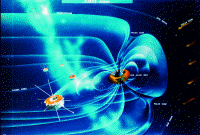CLUSTER II
Short Description:
ESA's Cluster II mission consists of four identical spacecraft flying in a tetrahedral (triangular pyramid) formation between 25000 and 125000 km above the Earth. They will study the planet's magnetic field and electric surroundings in three dimensions. In particular, they will be looking at the effects of the solar wind, which buffets Earth's protective magnetosphere.
Each of the Cluster II spacecraft carries an identical set of 11 instruments. These are sensitive to electric and magnetic fields, various electric and magnetic waves, and to electrons and charged atoms.
The mission is a direct repeat of the original Cluster project lost during the explosion of the Ariane-5 demonstration flight in June 1996. Cluster II will be based on the original mission, even using some of the original spare parts. Its scientific objectives also remain unchanged.
The names of the four: Rumba, Salsa, Samba and Tango.
Project Type:
Instruments for satellites
MPE Contribution:
Cluster Ion Spectrometer (CIS)
Electron Drift Instrument (EDI)
Fluxgate Magnetometer (FGM)
Status:
launch: July16, 2000 ; Soyuz
August 9, 2000 ; Soyuz
actual status: active; all 4 satellites in Earth orbit
end of mission: mission extended until 2020
Links:
German Cluster Data Centre (GCDC)
Space Physics of Near-Earth Environment

